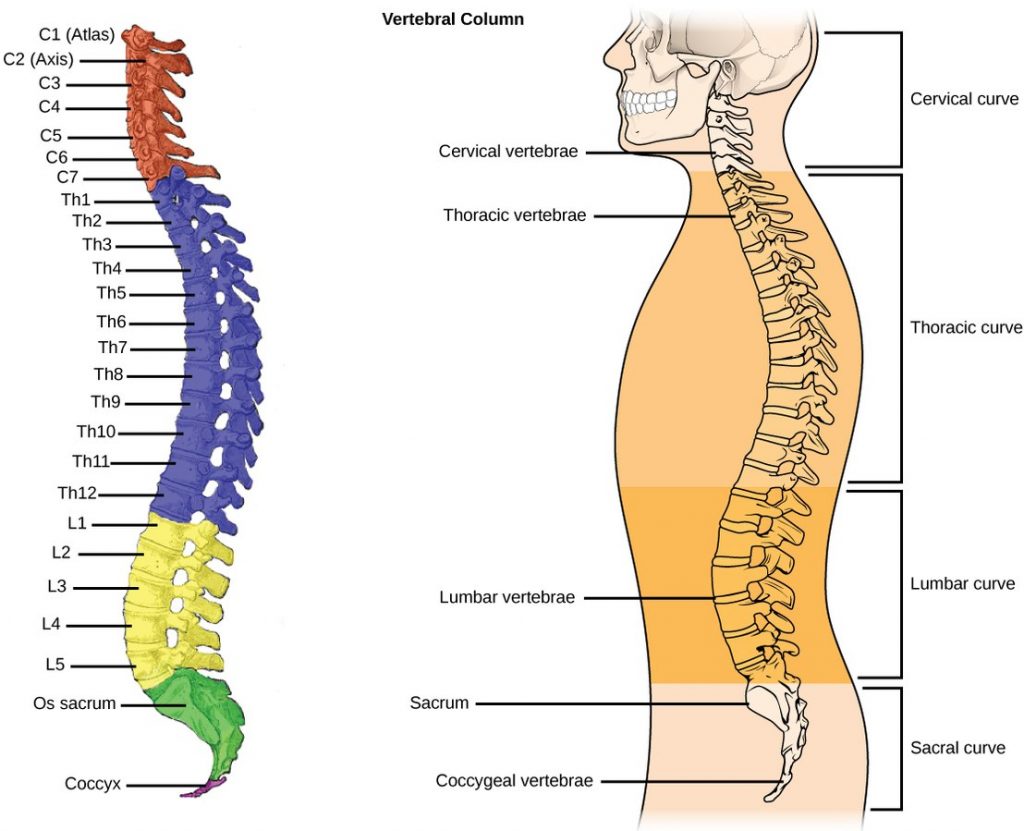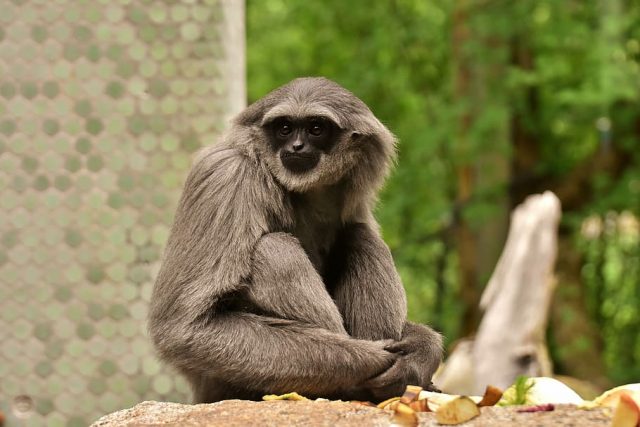If you ever tried to climb a tree in your adult life, you probably had two thoughts in quick succession. 1) Humans are related to monkeys. 2) Humans are definitely not monkeys.
Since my lumbar spine sucks, I started wondering if I would fare better if I inherited another kind of primate spine. But what would that even mean? How similar are human lumbar spines to those of other primates? Are they prone to the same sorts of injuries? And if not, then why did humans evolve such an obviously flawed system?
The Human Spine Today
Before we start looking at monkeys, here’s a refresher on human spinal anatomy: Humans typically have 7 cervical, 12 thoracic, and 5 lumbar vertebrae. 5 vertebrae are fused in the sacrum, and 4 in the coccyx.
One thing modern humans (and old-world monkeys in general) don’t have is a tail. This has some larger anatomical implications. Since we don’t have tails, we don’t need muscles to control those tails, and the vertebral attachment points are freed up. Our pelvic floor muscles moved into this real estate.

An Overview of Primate Spines
Is the human lumbar spine long, or short? The answer very much depends on which branch of the primate family tree you use for comparison. Compared to other great apes, humans have a large number of lumbar vertebrae. Chimps, orangutans, and western gorillas typically have 4 lumbar vertebrae, while eastern gorillas have 3.
But if you swing over to other branches, you’ll find animals with longer lumbar spines. Macaques typically have 7 lumbar vertebrae, while baboons have 6 or 7. Among the new world monkeys, tamarins have 7, while titi monkeys can have 7 or 8.
Relatives with even longer lumbar regions can be found in prosimian groups of lemurs and lorises. Wooly lemurs have 8 lumbar vertebrae, while dwarf lemurs have 9.
Table adapted from The Numbers of Vertebrae in Primates.| Family | Genus | Common Name | Avg. No. of Lumbar Vertebrae | |
|---|---|---|---|---|
| Prosimians | Daubentoniidae | Daubentonia | Aye-Aye | 6.8 |
| Lemuridae | Lemur | True Lemur | 6.7 | |
| Myoxicebus | Gentle Lemur | 7.3 | ||
| Lepilemuridae | Lepidolemur | Sportive Lemur | 9.3 | |
| Cheirogaleidae | Microcebus | Dwarf Lemur | 6.6 | |
| Chirogale | Mouse Lemur | 7.0 | ||
| Indriidae | Lichanotus | Woolly Lemur | 8.0 | |
| Loridae | Loris | Slendar Loris | 8.3 | |
| Nycticebus | Slow Loris | 7.1 | ||
| Perodicticus | Potto | 6.2 | ||
| Galago | Bush Baby | 6.0 | ||
| Tarsiers | Tarsiidae | Tarsius | Tarsier | 6.1 |
| New World Monkeys | Callitricidae | Hapale | True Marmoset | 6.3 |
| Oedipomidas | Marmoset | 6.6 | ||
| Leontocebus | Tamarin | 7.0 | ||
| Cebidae | Callicebus | Titi Monkey | 7.5 | |
| Aotus | Night Monkey | 7.1 | ||
| Pithecia | Saki | 6.5 | ||
| Cacajao | Uakari | 6.0 | ||
| Alouatta | Howler Monkey | 5.1 | ||
| Saimiri | Squirrel Monkey | 6.7 | ||
| Cebus | Capuchin Monkey | 5.6 | ||
| Lagothrix | Woolly Monkey | 4.3 | ||
| Ateles | Spider Monkey | 4.1 | ||
| Brachyteles | Woolly Spider Monkey | 5.1 | ||
| Old World Monkeys & Apes | Cercopithecidae | Macaca | Macaque | 6.9 |
| Cynopithecus | Black Ape | 6.8 | ||
| Papio | Baboon | 6.5 | ||
| Theropithecus | Gelada | 6.5 | ||
| Cercocebus | Mangabey | 6.5 | ||
| Cercopithecus | Guenon | 6.9 | ||
| Erythrocebus | Red Guenon | 7.0 | ||
| Semnopithecus | Langur | 7.0 | ||
| Nasalis | Proboscis Monkey | 6.9 | ||
| Colobus | Guereza | 6.8 | ||
| Hylobatidae | Hylobates | Gibbon | 5.1 | |
| Symphalangus | Siamang | 4.5 | ||
| Hominidae | Pongo | Orangutan | 4.0 | |
| Pan | Chimpanzee | 3.6 | ||
| Gorilla | Gorilla | 3.7 | ||
| Homo | Human | 5.0 |
There’s some messiness to the data. Some families show significant variation. If we grouped primates only by number of lumbar vertebrae, spider monkeys would be in the same category as apes. Their sister species could be grouped with prosimians.
You may also be wondering how a loris can have 8.3 vertebrae, or a black ape can have 6.8. After all, vertebrae come in whole numbers. It turns out that significant variation can be found within species as well. About two-thirds of lorises have 8 vertebrae, while a third have 9, which puts the average at 8.3. Three-quarters of black apes have 7 vertebrae, while one-quarter has 6, which puts the average at 6.8.
Spinal Variation in Modern Humans
But humans have a nice, neat number of vertebrae. Does this mean that Homo sapiens are more uniform than our primate cousins? Perhaps they all had a conference back in Africa, and decided that 5 was the ideal number of lumbar vertebrae.
That, of course, is not what happened. Human beings today still show significant variation in the number and arrangement of vertebrae (albeit less so than in other primates).
One study examined MRIs from 207 patients, and found that 16 (7.7%) had an alternate number of pre-sacral vertebrae. Seven patients had one less vertebra, and seven had one more. The remaining two had an unexpected transitional vertebra between the lumbar and sacral regions.
This sort of variation can be hard to detect if doctors aren’t specifically looking for it. Most scans don’t show the entire spine, and radiologists don’t always watch for anatomical variation, so it can be easy to overlook the occasional transitional vertebrae. This can lead to embarrassing errors, like performing surgery on the wrong spinal level.
How Do You Lose a Vertebrae?
The number and type of vertebrae that develop is determined by a group of numbered genes called Hox genes, which coordinate many aspects of neural development.
There are a few ways in which gene expression can change the development of the spine. Most commonly, a primate will retain the same total number of vertebrae, but one or more will shift to another spinal section. For example, a human could end up with only 4 lumbar vertebrae, and 6 fused sacral vertebrae.
Less commonly, an entire vertebra will appear or disappear.
Short-Backed Apes
The vertebral composition of ape progenitors is still very much a matter for debate. It doesn’t help that vertebrae are delicate bones that don’t preserve easily, so ancient ape specimens are rarely found with complete spines. Paleontologists often have to make educated guesses to reconstruct individual spines.
Some scientists believe that the last common ancestor of today’s great apes (including humans) had already developed a short lumbar spine (with 3-4 lumbar vertebrae) before the surviving branches split. This theory has a beautiful simplicity to it. If apes started out with short backs, then it’s easy to explain how chimps, bonobos, and gorillas all ended up with that arrangement.
But other scientists believe that the last common ancestor had more lumbar vertebrae (6-7) than living ape species. They point out that the lumbar spines of the great apes are quite different except for the number of vertebrae. Clearly, each species was finding its own solution to its low-back problems, so it’s not terribly far-fetched to think they converged in this one area.
Also, the ancient Australopithecus’s lumbar count of 5-6 is tough to explain if it evolved from a common ancestor with only 4 lumbar vertebrae. It’s hard to imagine why one species would spontaneously evolve a feature which seems to be maladaptive in every other related lineage. It would be the evolutionary equivalent of the military spontaneously deciding to write “absent without leave,” instead of “AWOL.” Long to short is easy, short to long is harder.
Regardless of when it happened, apes evolved shorter backs than their monkey cousins. There must be some compelling reason why all living apes converged on the same strategy.
At this point, I will draw your attention back, once again, to spider monkeys. Compared to their Cebidae cousins, they have curiously short lumbar spines. So the scientific riddle is: How is a spider monkey like a human?
While you ponder that riddle, take a look at this spider monkey playing on a tree. I’ll give you a hint: it’s not about the tail.
Need another clue? Check out this gibbon, which is a close relative to the apes, and also has a fairly short lumbar spine.
Now contrast both animals’ styles of movement with these ring-tailed lemurs, which have 7 lumbar vertebrae.
Perhaps you noticed that, while all three of these primates are skilled acrobats, they don’t all swing about in the same way. While lemurs can scuttle up a cliff like a mouse up a pant leg, they’re still basically quadrupeds.
By contrast, spider monkeys and gibbons tend to swing from the trees. Their posture tends to be upright. Their shoulder blades are at their backs, and their exceptionally mobile shoulder joints are positioned at their sides.
This anatomical re-jiggering of the shoulders left less room for strong back muscles, which meant these primates had a harder time keeping their lower backs stable. By reducing the number of vertebrae, primates with sideways-facing, flexible shoulders could avoid crumpling like a cheap umbrella whenever a sibling tackled them. (Modern apes have also moved the attachment points for some muscles, so that the loss of muscle mass is partly offset by better leverage.)
Gorillas, chimps, bonobos, and orangutans have made greater sacrifices in the name of stability than humans have. They tend to have narrower pelvises that trap their lower lumbar vertebrae between the iliac crests. These vertebrae are further immobilized with strong ligaments.
Stable, but Not That Stable
Humans, then, are a frustrating paradox. Why don’t we get stable spines, like gorillas and chimps? If any primate needs spinal stability, shouldn’t it be us? After all, we have to stay balanced on two legs, and we can’t use our knuckles or tails for support. If we need to carry a bucket of water, or a squirming toddler, our spine needs to absorb the extra force while remaining steady. So why do most humans have five lumbar vertebrae? And why don’t we have vertebrae that lock into our pelvis?
The human spine is all about the curves – lordosis and kyphosis. These curves help us to absorb shock while walking, and, especially, while running. If you’re a runner, you probably either have a curvy lumbar spine, or wish you did. One study showed that a 1% increase in lumbar lordosis corresponded to a 10% increase in lumbar shock absorption when running.
The degree of lordosis also influences how people walk. People who are coached to walk with more or less lordosis also change their gait. If the curve is flattened (called hypolordosis), people tend to walk more slowly, and take shorter steps. If the curve is exaggerated (hyperlordosis), people tend to walk faster.
In one fascinating experiment, researchers found that people pick up a box from the floor differently depending on the degree of their lumbar curve. Those with curvier spines were more likely to bend through the spine, while those with flatter backs were more likely to squat down and keep their backs straight.

Photo from Variation in lifting kinematics related to individual intrinsic lumbar curvature: an investigation in healthy adults
Parting Thoughts
While I’m still not thrilled with my spine’s tendency to irritate my sciatic nerve, I do like being able to walk upright. And while I don’t do a lot of bending around the hips, I want my lumbar spine to work independently of my pelvis.
A human lumbar spine, for all its weaknesses, is still the most suitable for my upright lifestyle.
Although if I was also offered a prehensile tail, and remarkable jumping abilities, I would totally be a spider monkey.
References
- Akbar, J. J., Weiss, K. J., Saafir, M. A., & Weiss, J. L. (2010). Rapid MRI Detection of Vertebral Numeric Variation. American Journal of Roentgenology, 195(2), 465-466. doi:10.2214/AJR.09.3997
- Been, E., & Bailey, J. F. (2019). The Association Between Spinal Posture and Spinal Biomechanics in Modern Humans: Implications for Extinct Hominins. In E. Been, A. Gómez-Olivencia, & P. A. Kramer, Spinal Evolution: Morphology, Function, and Pathology of the Spine in Hominoid Evolution (pp. 283-299). Springer.
- Castillo, E. R., & Lieberman, D. E. (2018). Shock attenuation in the human lumbar spine during walking and running. Journal of Experimental Biology. doi:10.1242/jeb.177949
- McCollum, M. A., Rosenman, B. A., Suwa, G., Meindl, R. S., & Lovejoy, C. (2010). The Vertebral Formula of the Last Common Ancestor of African Apes and Humans. Journal of Experimental Zoology, 123-134.
- Nakatsukasa, M. (2019). Miocene Ape Spinal Morphology: The Evolution of Orthogrady. In E. Been, A. Gómez-Olivencia, & P. A. Kramer, Spinal Evolution: Morphology, Function, and Pathology of the Spine in Hominoid Evolution (p. 73*96). Springer. doi:10.1007/978-3-030-19349-2_5
- Pavlova, A., Meakin, J. R., Cooper, K., Barr, R. J., & Aspden, R. M. (2018). Variation in lifting kinematics related to individual intrinsic lumbar curvature: an investigation in healthy adults. BMJ Open Sport & Exercise Medicine, 4(1). doi:10.1136/bmjsem-2018-000374
- Schultz, A. H., & Straus, W. L. (1945). The Numbers of Vertebrae in Primates. Proceedings of the American Philosophical Society, 601-626.
- Shapiro, L. J., & Russo, G. A. (2019). Vertebral Morphology in Hoinoids II: The Lumbar Spine. In E. Been, A. Gómez-Olivencia, & P. A. Kramer, Spinal Evolution: Morphology, Function, and Pathology of the Spine in Hominoid Evolution (pp. 51-72). Springer.

One thought on “Human vs. Primate Lumbar Spines: What Have We Gained? What Have We Lost?”